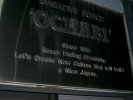
As a travel web site put it, "Japan is the subject of more gullible and misguided musings than perhaps any other place in the world". So now it's time to add some of my own.
Before going to Tokyo, I read the usual guide books and asked a few people who had been there. The general gist was "It's a strange place, it's very difficult. Prepare for culture shock. But don't worry, you'll be able to handle it." (Except for one person who essentially claimed "Tokyo is a city. You know cities. No problem.")
Well, so far (I'm writing this bit at about halfway through the trip) the biggest bit of culture shock was this sign:
Why did this one irritate me?
But given that this was the oddest bit I've noticed, it is probably obvious that I haven't got much of a culture clash. Tokyo is a very convenient city for me. I've done quite a bit of walking around and it has a lot of variety. After having all the travel guides going on about 'the bookseller district', 'the electronics district' and the 'plastic dishes district', I assumed that there were lots of rather uniform neighbourhoods in Tokyo. But walking around, the sights change rather quickly, with an interesting mixture of expressways, main streets, tiny back alleys, residential blocks, small houses, office towers, and so on. I like that when walking around, since it's much more fun than places that have large residential areas where you walk past identical looking houses for miles before getting to the shopping mall.
Yes, I can't read most of the street signs and shop ads, but I can't do that in Greece either, and that never worried me in Athens at all. And the subway is not harder to use than, let's say, the Metro in Paris.
In short: It's a city. I can handle those.
Even though I have to admit that walking around with a GPS is very convenient. I've got the hotel stored as a waypoint, so I can just walk around at random and then head in the direction of the hotel without bothering to look at the map or even trying to figure out where I am. And this brings me through areas I wouldn't have visited by following the map and main sightseeing spots, but provides a sort of random selection of places on the way. (On the other hand, I sometimes find out later that I walked quite close to a place that might have been worth visiting. But there's always the chance to go back later...)
A side effect of the GPS use is that you know rather precisely where you've been and how far you walked. I was rather surprised when I noticed that I had been walking almost 130 km in Tokyo in about a week...
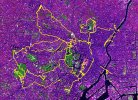
Side remark: At some point I started to wonder what would be a good criterion for defining "city" (a 'real' city as opposed to a place where just a lot of people live - cities that 'feel' like a real city can actually be quite small, while other places with lots of inhabitants are at best population centres). Maybe "a place where you can get everything somewhere" is a good working definition. You can probably get Kirin Beer easily in Berlin, cuckoo clocks in San Francisco, or small porcelain statues of the Empire State Building in Tokyo, if you know where to look. (In extension, a metropolis would be a "a place where you can get everything somewhere at any time", with other cities being just places daydreaming about being a metropolis...)
Anyway, back to the subject at hand.
The main thing about Tokyo so far is that almost all stereotypes about the city turn out to be just that: stereotypes. While a lot of them are somewhat based on truth, they aren't as rigid as they seem to be in the represented in the guide books. At least for the way I travel. Let's take the subway. While it is supposed to be extremely crowded in the morning, it turned out to be a lot less crowded than the one I take to work at home. (Ok, I was going away from the city centre in the morning, and the trains coming in from that direction looked a lot more crowded, but that means about the same crowd as a subway back home.) Sidewalks are no more crowded than in other cities, and while the percentage of people in dark colour suits is really higher than in other places I've seen, it's far from a uniform "everyone looks the same" appearance in the streets. And while cycling has not quite reached the levels it has in Amsterdam or Berlin, a travel guide stating "Cycling would clearly be madness." and "even the locals find it tough" is clearly way off reality.
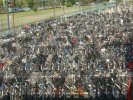 Nobody uses bikes - yeah, sure...
Nobody uses bikes - yeah, sure...
The same probably goes for renting cars. I didn't do either (cycling or driving a car), but there does not seem any real reason not doing it. Doesn't seem more difficult than most other places.
It's also not as expensive as everyone leads you to believe. Yes, it is a city of luxury and you can spend vast amounts of money on things if you want to, but I was expecting to eat mostly noodle soups in railway stations for $20 and in reality I've just had a very good lunch box with various bits of meat, fish, fruit and rice for about $6, which is actually a better value for money than my lunch at home.
And on and on and on...
Tokyo clearly has its own personality, but it's far from the closed book that leaves foreigners bewildered, alienated and confused.
Maybe I need to put this image first.
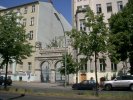
It's not from Tokyo at all, but it illustrates a point. It's from Berlin and what it actually says is "Canalisation der Stadt Berlin - Pumpstation 6". Yes, that basically means it is a pumping station for the sewage system. I've seen tourists taking pictures of this and in some cases, I'm not sure whether they realized what they were photographing. If you can't read the sign, the entrance has a bit of a mysterious feel to it, like an ancient entrance way to some old park maybe, still remaining somewhere behind the modern buildings.
Tokyo has quite a lot of shrines and temples. Some of them fairly obvious, well known and mostly tourist attractions, but a lot of smaller ones coming up rather surprisingly at street corners or in back streets. But since I can't read the signs, I may as well have been making pictures of entrances of chinese restaurants, houses designed in old style fashion, garages or entrances to the sewage system. This slightly bothered me for a day or so, but since I don't go to shrines and temples for some sort of spiritual experience, just to look at them and take pictures, it doesn't really matter. If I like the look of it, I enjoy it, even if it's just a designer garage.
One of the buildings that clearly is a shrine is the Meiji-Jingu shrine at Yoyogi park. (A neat feature is the 'wishing tree', where you write your prayers on a little slice of wood and hang that on a display that surrounds the tree. Given the rather public nature of this, most wishes seen to go along the lines of "Wish for health and happiness" and the ever popular "World Peace" (as opposed to fame or money), and although I haven't seen one wishing for a "Nice Japan", it would have fitted right in. I wondered whether I should put a quickly scribbled one on, wishing for a more readable handwriting, but decided against it,)
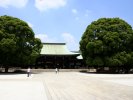

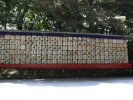
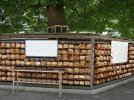
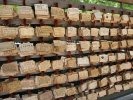

Another of the big shrines is the Senso-Ji shrine, which is right next to the Asakusa Pagoda. I went there one evening after a tour on one of the Tokyo bay boats, where I had a lot to eat and way too much sake to drink, so a bit of a walk seemed like a good idea and it's wasn't very far to the shrine anyway.

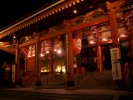


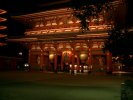


Another large shrine, which is also close to another tourist attraction, is the Zojoji Temple, right next to the Tokyo Tower.
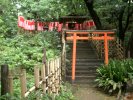
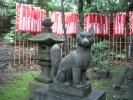


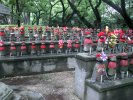
The proximity to Tokyo Tower gives me a convenient link to Tokyo Tower itself. One of the more irritating features of Tokyo Tower was this:

It is a bit difficult to see, but the writing on the plaque is actually Braille. Why would anyone put a sign on a viewing platform in Braille? Presumably it describes the sights from this window, but somehow it all seems a bit pointless. Why would a blind person go to a viewing platform at all? They could have put the sign somewhere in the cellar and have the same effect. There's sometime that joke about why there is Braille lettering on drive-in ATMs, but that actually makes more sense than having it on a viewing platform.
A rather cute feature on the viewing platform were the large touch screen displays.
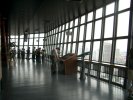
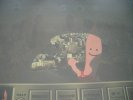
In every compass direction there was display that explained about the buildings and areas that could be seen. The displays also had a button to show the 'night view' and the 'fine weather' view. But when one of these views was selected, it didn't come up immediately. At first there was a rather dim view shown, before an animated mascot of the tower started to 'clean' the screen and reveal the actual view. Cute idea!
A couple of views from Tokyo Towers:
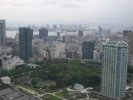
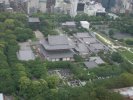
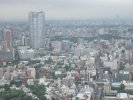
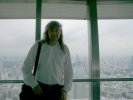
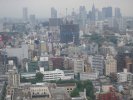

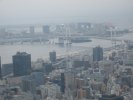
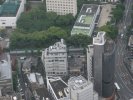
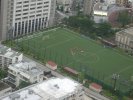

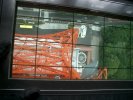
The viewing platform at Tokyo Tower gives me a thematic link to another viewing platform, namely the one at the Tokyo Metropolitan Government Building, the tallest skyscraper in Tokyo, which has a viewing platform at the 45th floor.

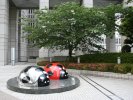
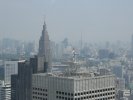
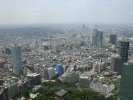
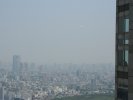
That's about how far I can keep the stuff thematically linked, so here are a couple of sites and sights that didn't fit in with the other pictures:
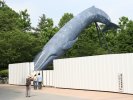 Life size whale statue in Ueno park
Life size whale statue in Ueno park
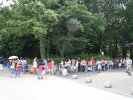 The reason why I didn't visit the science museum. (They had a dinosaur exhibition there, which pulled large crowds...)
The reason why I didn't visit the science museum. (They had a dinosaur exhibition there, which pulled large crowds...)

 Godzilla protecting the flowers of some house in the suburbs
Godzilla protecting the flowers of some house in the suburbs
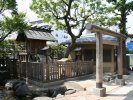 Small shrine at street intersection
Small shrine at street intersection
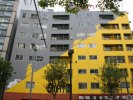 Tortoise(s) and the Hare wall painting
Tortoise(s) and the Hare wall painting
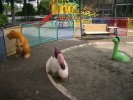
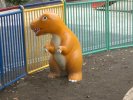 Why weren't there playgrounds like this when I was a kid?
Why weren't there playgrounds like this when I was a kid?
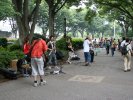
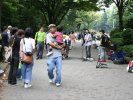
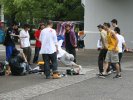 Probably the saddest sight in Tokyo
Probably the saddest sight in Tokyo
For quite a couple of years, teenage bands gathered at Yoyogi Park on Sunday afternoons to play. After a while it was shut down, later it re-emerged at a somewhat smaller scale. Well, remains of this still exists and it's sad. Along a path at the side of the park, there is a band about every 50 meters, alternating on the sides of the path. One band plays two or three songs, then stops for a while to give the bands to the left and right to play their bit. Except for a couple of tourists who snap a couple of quick pictures and walk on, shaking their heads, and two or three friends of the band, nobody cares.
The bands do their best to be hip, trendy and cool and there seems to be a quiet desperation to break out of the 'stale society' and be rebellious. And nobody is interested at all. But they still go on...
I've seen such a sad scene once in Nelson, New Zealand, where a bored Jazz band was playing old time songs in a hotel bar for a bored audience that didn't care. It seemed like a musician's hell. But at least it was hidden away in an elderly hotel, where this at least sort of fitted. And there was no attempt of being anything but old fashioned. But in Tokyo, these are young street musicians, trying to be non-conforming and outrageous and they come across as about as innovative as Elvis imitators in Vegas. Or, to put it another way, even people singing 'My Way' in Karaoke bars are conveying more rebellious spirit than they do.

Sometimes it seems that Tokyo is just a number of buildings built around drink vending machines.
The number of (mostly soft drink) vending machine is staggering. (After reading somewhere that
one concept of making tall building earthquake resistant by putting large, well-sprung, water tanks
into them, to dampen the vibrations, I started to come up with the pet theory that these
vending machines are probably the reason why Tokyo has not been destroyed by earthquakes
yet. There's so much liquid in all those vending machines, that most earthquakes should be
well dampened.) Anyway, the vending machine shown above is a beer vending machine, which not
only offers normal beer cans, but also giant (probably 2 litre) bottles of beer...

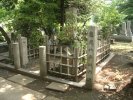
The obligatory shaggy dog story...
Hachiko is a rather famous dog in Tokyo. He belonged to a professor, who lived close to
Shibuya Station. Every day, the dog accompanied the professor to the station, wait there
until the professor came back and walk home with him. On day the professor died, but the
dog still went to the station every day for the next ten years, waiting in vain for his
owner to come back.
Even back in 1925, this was a story that impressed many people, so they put up a statue
of the dog in front of the station, as a memorial to the dogs loyalty. When the dog died
in 1935, they buried him in a small grave on the professor's burial plot Aoyama Cemetery.
I didn't spend all the ten days in the city centre of Tokyo, but also did a couple of detours.
The first one was going carting in Hiratsuka. Not that I'm any good at it (I finished last, being overtaken on the last lap), but it was a fun thing to do.
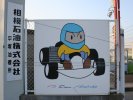

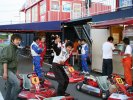
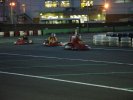
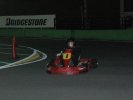
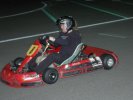
The second trip was to the Ghibli Museum in Mitaka. Ghibli is the animation studio founded by Hayao Miyazaki, who directed such movies as "Laputa: Castle in the Sky", "Spirited Away" and "Princess Mononoke". Getting into the museum is slightly tricky if you're not Japanese. You can't actually buy a ticket, you need a voucher for a ticket, which you either have to get in advance from an office in New York (which doesn't actually work - I've tried) or (for Europe) from one in London, which doesn't seem to know about the museum at all. Or you can try to buy one for the same day, if available, in the centre of Mitaka somehow, but the details are rather unclear. So while it presumably is possible to visit the museum on your own, the only practical way seems to do a guided afternoon tour, which doesn't leave quite as much time at the museum as I would have liked, but as a bonus, you get a japanese tour guide, who can translate signs and explain things.
You aren't allowed to take pictures inside the museum, but you can take pictures from the outside and on the roof (where a giant robot soldier and the cube from "Laputa" are located). [Being not allowed to take pictures inside wasn't as bad as I feared it to be. There is a very good guide book available at the museum, which basically shows all the things I would have liked to have photographed and it even has an english translation in the back.]
Next day trip was to the Disney parks. There are two such parks in Tokyo, the older Disneyland and the newer Disney Sea.
I've visited Disney Sea first.
It's a neat park, which is only barely recognizable as Disney. There are two areas that are 'typically' Disney (Ariel's Mermaid Lagoon and Aladdin's Arabian Coast), but most of the areas are generic 'seaside' areas that are only vaguely linked to Disney movies. There is an American Waterfront, the Mediterranean Harbour, a Lost River Delta (featuring Indiana Jones), Port Discovery (featuring the 'Stormchasers') and a Mysterious Island and volcano (featuring two Jules Verne stories, "Journey to the Centre of the Earth" and "20000 Leagues under the Sea"). All areas with lots of detail and charm and surprisingly large amount of 'uncramped' space. To a certain extent closer to EPCOT than to Disneyland.

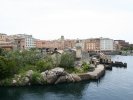
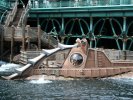
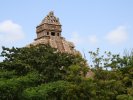
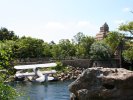
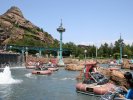
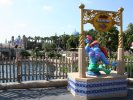
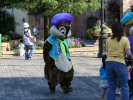
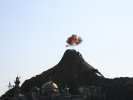
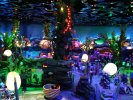

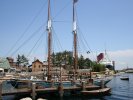

While Disney Sea is the more modern and more interesting environment (and I spent most of the day there), I also wanted to visit Disneyland. I have been to the incarnations in Anaheim, Orlando and Paris, so I wanted to have the 'full set'. Unfortunately (or, more accurately, by fiendish design), there is no ticket that allows you to visit both parks on the same day for a reduced price. While there are 'two parks' tickets, they only allow you to go on consecutive days, forcing you to spend two or more days (which I didn't have) in the parks. The only alternative to full price tickets is using the reduced 'after 6 pm' ticket, that allows entry in the evening for a reduced price. So I spent most of the day at Disney Sea, then did a short detour to the Tokyo Sea Life Park (which is just one train station away) and went to Disneyland at six. Since the sun sets rather early in Tokyo, even in summer (around 7 pm), I didn't get to take many pictures of the park, but I managed to get a few nice nighttime shots of a show, the electrical parade and the fireworks. I also didn't manage to visit many attraction, but I did manage to visit "Phantom Manor / Haunted Mansion", so I have seen at least this attraction in all existing variations.
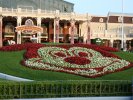

This is a rather odd sign, that doesn't quite make sense. It seems to be either badly spelled English or half-German. Not quite sure what this is supposed to signify.
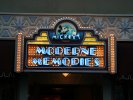
Bring on the night...
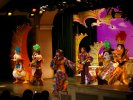
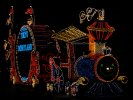

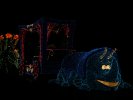
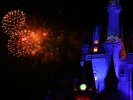
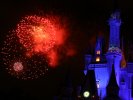
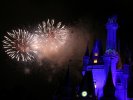
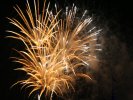
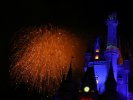
The final day was spent visiting the Hakone area. It's a convenient day trip from Tokyo. Supposedly, it would be a better idea to visit Nara and Kyoto, but that is not really a sensible day trip (two days would be needed at least), so I decided to go to Hakone, even though the 'standard' day trip seems to be Nikko, but since I usually prefer landscapes to buildings, seeing the lake and volcanic site was more promising than historic shrines.
After a trip with a wide selection of means of transport (starting with a regular train, then a Swiss built mountain train with switchbacks, followed by a cable car, and finally a ropeway) I arrived at the volcanic area.
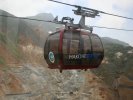
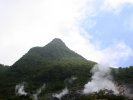
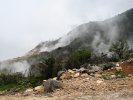
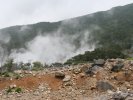
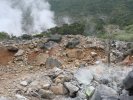
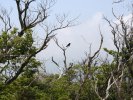
The attraction here, as odd as it may sound, are black eggs. Which are very popular. They even build a small ropeway, just to transport egg crates from the main building to the sales hut.
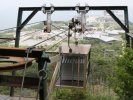
At the sales hut, you can buy a bag containing six black eggs.
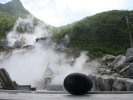
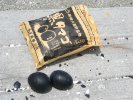
They boil the eggs in the hot volcanic waters and the sulphur makes the shell turn deep black. This looks scarier than in is. While there is a smell of rotten eggs in the air, this is from the volcanic vents, not from the eggs. And it's just the shell that takes an odd colour. The egg underneath is just a normal, hard boiled egg.
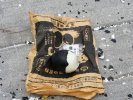
The scary bit (at least for me) is something else: The little bag with white stuff that comes with the eggs. When I'm going to eat six eggs, I'd like to put a bit of salt on them. But during the previous couple of days, I noticed that there are quite a few food items in Japan that come with a little packet of white stuff. Which is some moisture absorbing stuff (typically silica gel) to keep cakes and cookies and such nice and dry. Now, with the eggs, it wasn't obvious what the white stuff was. It might have been just salt, but it might also have been some desiccant (the formal name for 'moisture absorbing stuff' - I just looked it up), which would not have been good to eat.
The writing on the packet didn't give any obvious clue (well, actually it probably did say in large and obvious letters 'Salt' [or 'Danger'], but not in a language I could read) and this turned out to be the only time during my stay in Japan where I had language trouble.
In the end, I did what every tourist would do in a case like this. I took out my camera, took a number of pictures of the eggs and the surroundings and waited for some Japanese people to handle their eggs. They opened their little plastic packets and put it on their eggs and ate them. I stopped taking pictures and ate my salted eggs. Language problems solved...
After that, the trip continued down to the lake with yet another ropeway. (And I have no idea why some of the cabins were decorated with frowning South Park style manga figures... [Ok, now I have. It's Kintaro, the bear-wrestling boy of local legend. The front of the cabin shows him getting angry and ready to fight, while the side of the cabin shows him celebrating the victory. Obvious, really.] )
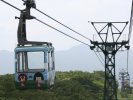
The next mode of transport turned out to be ... pirate ship!
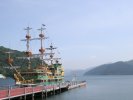
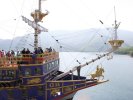
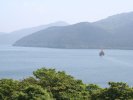
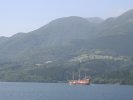

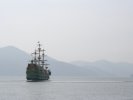
For some (never made clear) reason, the ships crossing Lake Ashi are looking like Disneyfied versions of European style pirate ships. Well, why not?
After being transported around most of the day, I went for a bit of a walk in the Hakone Detached Palace Garden and along the Cedar Avenue.
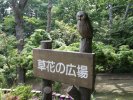



After that it was time to take the bus back to the train station and go back to Tokyo, from where I flew home the next day.
So that's about it for the Tokyo trip.
As a final image, a case of creative hyphenation:

Which, by the way, was a rare find. I was quite eagerly looking (for reasons I'm not really going to explain) for strange English phrasings and cute misspelling, but I found that a lot of care had been taken to make them accurate.